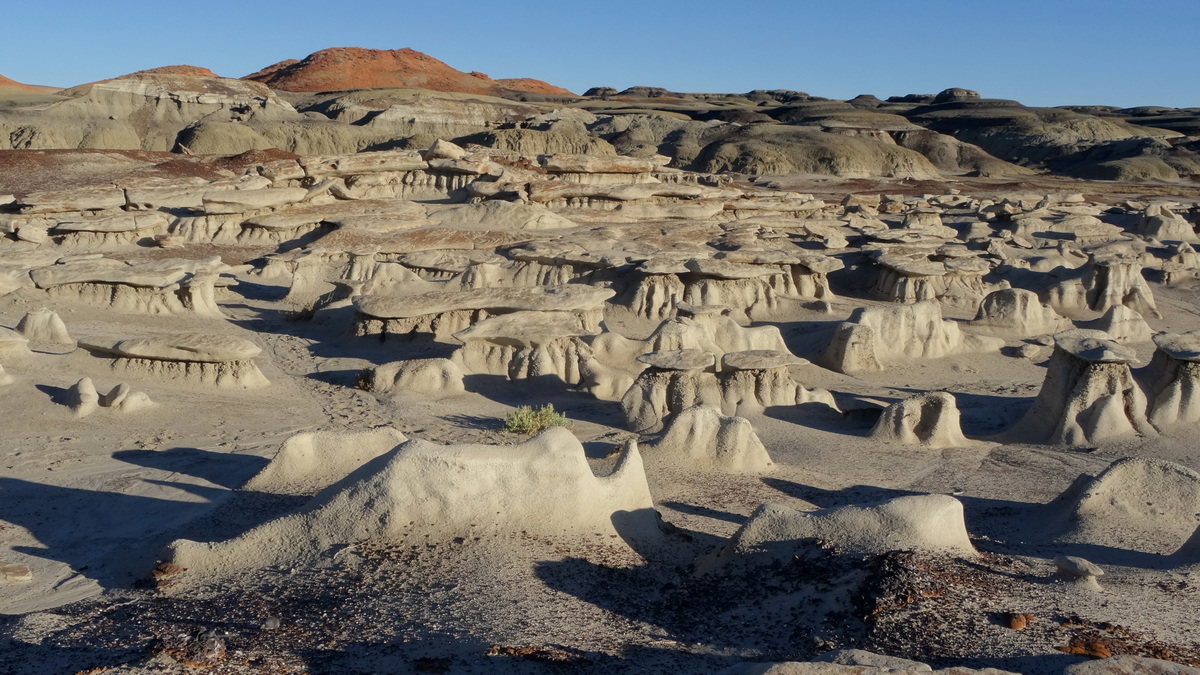Comments from the Chair
1) Climate Action & Adaptation Plan (CAAP): I am pleased to report that the City of San Antonio (COSA) City Council APPROVED/PASSED the CAAP on October 17, 2019, by a vote of 10 FOR (including the Mayor) and 1 AGAINST (Council District CD 10 Member Clayton Perry). Many strong comments were made from the Mayor and Council Member, as well as from the public. These can be found at the helpful link prepared by sometime member and always climate activist Peter Bella (many thanks!): .”I consider the comments made during the October 17 meeting by City Council, and the answers Doug [Melnick, Sustainability Chief] provided to their questions, to be critical in guiding our understanding of efforts moving forward. For that reason, and frankly to further memorialize the passage of the plan, I have edited from the City's livestream video the Citizens To Be Heard comments as a single video, as well as the comments by individual Council members. The webpage linked by this URL contains individual video clips, each of which can be downloaded, as well as links to all materials provided by the City for the October 17 City Council A Session including a PDF copy of the slides used by Doug Melnick to present the CAAP. Videos and Resources: San Antonio City Council Approves the Climate Action & Adaptation Plan, 10/17/2019: https://bit.ly/2W5PvOd." The CAAP does NOT include the strengthening language we and others urged. It DOES provide a framework for this language to be included in IMPLEMENTATION. We MUST WORK FOR STRONG IMPLEMENTATION LANGUAGE, with specific interim targets and pathways spelled out.
2) CPS ENERGY: On the day of the CAAP vote Councilman Perry quoted a letter received that day from CPS CEO Paula Gold-Williams in which she stated "Accelerating the closure of [coal] plants could leave the community in the position of paying twice for energy capacity. Paying for assets already owned and paying for new solutions simultaneously could make San Antonio one of the most expensive energy markets in Texas, and perhaps, the nation." The CAAP steering and technical working group committees had asked CPS for over a year to provide modeling data so that pathways to early closure of the Spruce 1 and 2 coal fired power plants could be discussed. The CAAP Committees were told technical staff were working on this and would have data for discussion, BY November 2018, later postponed to JANUARY 2019. The PGW letter to CM Perry was the first substantive response we have received. This unexpected two line response without ANY supporting data is UNACCEPTABLE, but not surprising, given the CEO and BOT unwillingness to alter in any way their “Business As Usual” approach to governance. This management team has learned NOTHING from the nuclear energy STP (South Texas Project) 3 and 4 expansion proposals of 10 years ago. Those plans were defeated by strong, well justified public opposition when the deceitful financial arrangements and cost overruns were exposed, requiring COSA action and BOT and CEO replacements. The debacle cost a write off of almost $400 M. Current BOT and CEO rejected public voices urging Spruce 2 NOT be built. Now they are stuck with this expensive, unneeded asset that pollutes our air, damages our health AND destroys our climate. The Spruce plants MUST BE CLOSED EARLY to achieve CAAP goals. BOT and CEO are unwilling to find a cost effective way to achieve this necessary step, and their opposition puts our CAAP, our health, our air quality AND our climate future at risk. They MUST comply with CAAP goals, or they MUST RESIGN OR BE FIRED. COSA HAS THIS AUTHORITY AND RESPONSIBILITY AND MUST EXERCISE IT!
3) SAWS: Our water utility is working on a new round of RATE INCREASES. The Rate Advisory Committee (RAC) has had its third meeting already (for more information see: https://apps.saws.org/who_we_are/community/rac/index.cfm). This is an important opportunity to correct the inequities introduced by the last round of rate increases in 2015 (and still going on, with another almost 10% increase already planned for 1/1/2020). The current RAC process will result in rate changes and increases extending into 2025. We are urging many specific changes, and especially new ways to decouple profit from sales so as to encourage much more conservation. The need for growth to pay for itself (sprawl should not be subsidized by current rate payers) is also a top priority for enhancing equity.
4) Transportation: ConnectSA is in the news now for its efforts to take away funding for our Edwards Aquifer Protection Program (EAPP, see https://www.sanantonio.gov/EdwardsAquifer) and possibly our Linear Parkway system as well. The mistaken idea being promoted is that the EAPP has been successful (true!) and is substantially complete (FALSE); this is the “only” funding source seen by our myopic politicians like Henry Cisneros and Judge Nelson Wolff. The millions collected by the 1/8 cent sales tax supporting EAPP will hardly touch our BILLIONS in mobility needs. We need to look to the state and federal legislation to free up more money for real congestion solutions like VIA transit, van and car pooling, SAFE, physically separated bike and pedestrian ways protected from motor vehicles etc. VIA Reimagined (for more information see: https://www.viainfo.net/reimagined/) is an ambitious, well thought out proposal that needs OUR SUPPORT and will do much more to help our mobility (for $850 M) than the $1 B TxDOT plans to spend making 23 miles of N 1604 into TEN LANES! This highway expansion virtually ALWAYS results in MORE SPRAWL AND MORE CONGESTION, not less. ConnectSA should also look at a major bond issue to support real solutions. The EAPP is critical to protecting our water, and many thousands of acres still need protection NOW, before costs skyrocket out of reach due to this endless sprawl. Please check out TxDOT 2050 proposals (visit https://www.txdot.gov/inside-txdot/division/transportation-planning/statewide-plan.html). Please speak out against more pavement and more sprawl BEFORE NOVEMBER 15: a) TTP 2050 Planning Priorities Survey at http://ttp2050.metroquest.com; b) UTP Programming Priorities Survey at https://www.surveymonkey.com/r/TTP_UTP; c) Emerging Technology Survey at https://www.surveymonkey.com/r/EmergeTech2050; d) and Transportation Usage Survey at https://www.surveymonkey.com/r/TTP2050.
5) PLASTICS: We, and especially our polite, persistent activist Alan Montemayor, have tried for over one year to reach top management at HEB--i.e. Charles Butt--WITHOUT SUCCESS. We wish(ed) to discuss possible ways HEB could reduce its use of plastics in its business, hopefully reducing its costs as well as its impact through plastic waste on our environment. It appears that HEB MANAGEMENT WILL DO NOTHING, UNLESS a) they hear from Charles Butt; or b) stores everywhere receive LOTS OF COMPLAINTS ABOUT PLASTICS FROM THEIR CUSTOMERS. HEB does NOT make this process easy. COMMENT CARDS are available, stamped with individual store number, but MUST BE SOUGHT OUT in hidden store offices. I URGE ALL SIERRA CLUB MEMBERS AND OTHER ACTIVISTS TO COMPLAIN ABOUT HEB PLASTICS. Alan also is in the habit of offering a reusable bag to someone in the check out line with none, encouraging them to skip the arm full of disposable single use plastic bags. We may soon need a more AGGRESSIVE PUBLIC CAMPAIGN AGAINST HEB FOR REFUSING TO HELP OUR ENVIRONMENT.
by Terry Burns, M.D., Alamo Group Chair
A Day in The Life of San Antonio’s Waste Management, The Problem with Plastic, and The Zero Waste Movement
We’ve all heard about macro- and microplastics in the environment and in our bodies, and the failures of plastics recycling. But what about San Antonio’s waste? How much is going to city landfills? How much ends up in our rivers? In particular, where are we most likely to purchase plastic; how can we reduce our plastic usage? What can we do about all that single-use plastic that comes home with us from the grocery store? And can a family of four really limit the waste they throw away to just one mason jar full per year??
Come and meet David McCary, the man whose job it is to process all of San Antonio's garbage and recycling. He will tell us about the mountain of solid waste our City sends to landfills, and simple ways to reduce the amount of stuff we throw out, some of which may surprise you. Karen Weehler will show us how we can minimize our waste by re-thinking what “waste” and “disposal” mean in our everyday lives. Alan Montemayor, environmentalist and retired mechanical engineer, will talk about his initiative to convince HEB stores to join Trader Joe’s commitment towards phasing out single-use plastic, and how you can be vocal, act locally, and vote with your pocketbooks and at the polls to stem the tide of plastics in our environment.
Tuesday, November 19th
6:00 pm - doors open; 6:15 - announcements; 6:30 pm - program starts
William R. Sinkin Eco Centro, 1802 North Main Avenue
Map
This meeting is open to the public
Speaker Bios
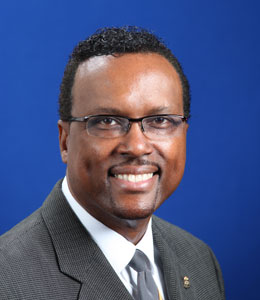
David W. McCary, CPM, MPA, has been Director of Solid Waste Management for the City of San Antonio since 2007. His team crafted the city’s first Recycling and Resource Recovery Plan in 2010 titled, “Creating a Pathway to Zero Waste”, with a goal to achieve a 60% residential recycling rate by 2025. Since 2015, he and his department have implemented various initiatives to reduce the amount of material going to our landfills, including a citywide green organic cart collection program to create compost and give those materials back to nature. In response to the 2017 devastating floods from Hurricane Harvey, McCary lead his Solid Waste Emergency Management Team to Houston where they became the first responders to provide post disaster recovery relief for the Kingwood Community. Before coming to San Antonio, McCary also directed solid waste collection operations for Houston, Texas; Durham, North Carolina; and Tampa, Florida. His innovations in solid waste management have resulted in millions of tax and ratepayer’s savings from each of these cities, all without one employee ever being laid off.
Karen Weehler, BS, MS, is Ana Sandoval's appointee to the City of San Antonio’s Office of Sustainability. A retired biology and environmental sciences teacher and member of the Executive Committee of the Alamo Group of the Sierra Club, she is a supporter of the Zero Waste Movement and has been looking particularly at the plastic problem regarding its production, short recycling life, and cost to the ocean and other ecosystems. In collaboration with Alan Montemayor, she has been looking at where consumers are most likely to purchase plastic, and what can be done to minimize the amount of plastic we all take home from the store.
Alan Montemayor, BSME, is a retired mechanical engineer and member of the Executive Committee of the Alamo Group of the Sierra Club. A passionate environmentalist, he brings his professional expertise to bear on the practical issues of energy conservation, renewable energy, and especially reducing plastic waste.his Ph.D. in Economics from Syracuse University specializing in Public Finance and Urban/Regional Economics. He taught Economics in the School of Business and Administration of the University of the Incarnate Word (UIW), 1987-2018, and now serves as Professor Emeritus of Economics at UIW. He was a Fulbright Scholar to the Universidad Centroamericana José Simeón Cañas of El Salvador (UCA), where he taught economics in the Graduate School of Finance, 1989-1991 and in the summers, 1992-2017. His research focuses on the public finance of inclusive economic development.
Bisti/De-Na-Zin Wilderness, Northwestern New Mexico
This place is administered by BLM; here’s the website which has a good slideshow. The Bisti (west) side is accessible for hiking and walk-in camping through a couple gates at parking spots via a 3 mile drive off New Mexico hwy 371, 38 miles south of Farmington. The De-Na-Zin (east) side is accessible via county road 7500 west from US 550, 25 miles south of Bloomfield. Vehicles are prohibited. This is not far northwest of Chaco Culture National Historic Park, about which there was an article in the October 2019 issue of this newsletter.
There is evidence of human occupation dating back to 10,000 BCE; these were the Ancestral Puebloans (formerly termed Anasazi). The Chacoan Great North Road passed through the far east section of this area. Here’s a PDF on Chacoan roads.
The geology particularly on the Bisti side is really spectacular; Wikipedia has an excellent article with pictures that makes this intelligible. There is virtually no vegetation across much of the area so the rock and soils are entirely visible. We get to walk past limestone and volcanic rock capped hoodoos across flats of eroded and redeposited volcanic ash, which is all termed the Bisti Badlands. Here is some specific info about hiking with lots of ideas by someone really knowledgeable. My pictures below are from visits October 2012 and September 2019.
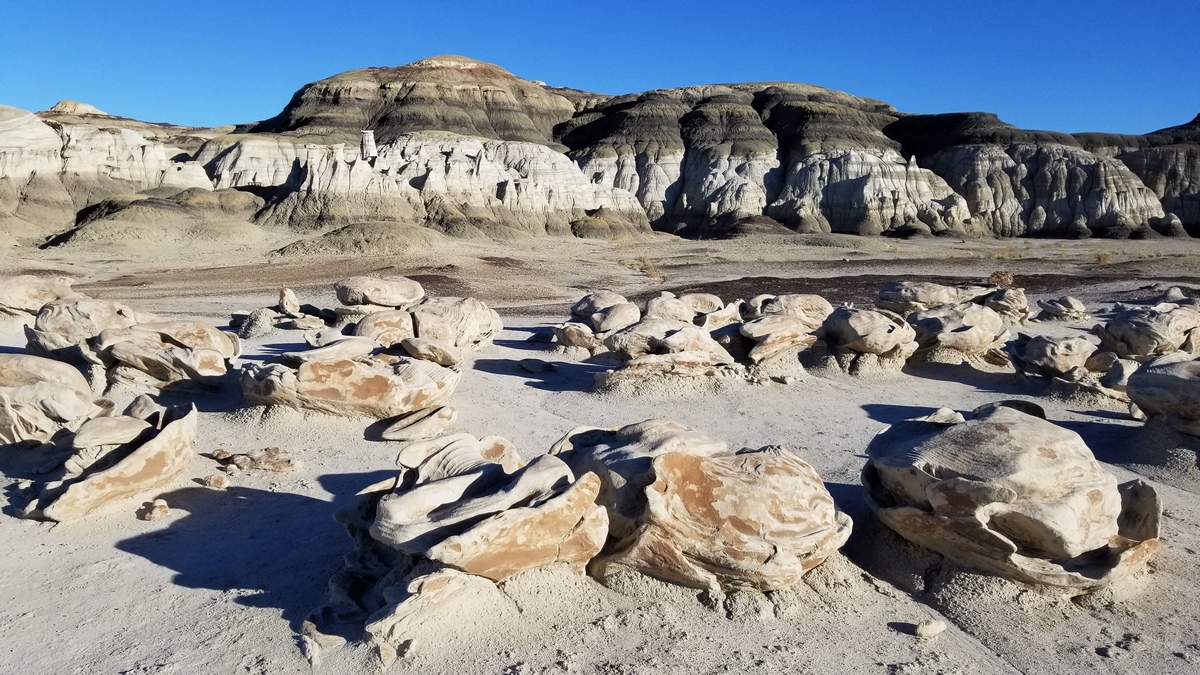
Strange limestone blocks, about 3’ wide, left after erosion of the surrounding volcanic ash.
Here’s another webpage with excellent pictures. As this page says, “The eastern side of the wilderness, known as the De-Na-Zin, from the Navajo for 'cranes,' has a lower concentration of the dramatic formations found in the Bisti. It more than makes it up with a seemingly endless desert badland solitude. With a more remote trailhead, the eastern side sees only a tiny fraction of the annual visitors who visit the Bisti. If you go a mile or two from the trailhead in the De-Na-Zin, you are alone in the world."
I did visit the De-Na-Zin side this year en route to Bears Ears National Monument, but could not appropriately capture the vistas myself. So these pictures are all on the Bisti side, taken in 2012 and this year.
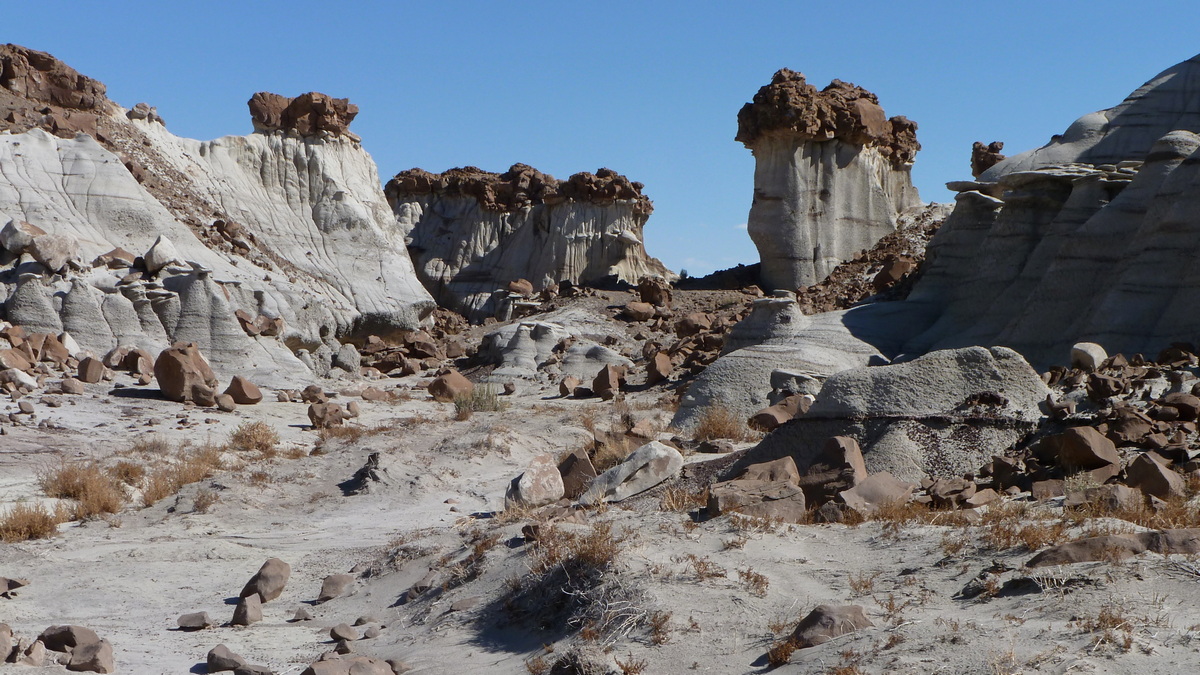
Caps of volcanic rock on volcanic ash.
One of many areas with limestone caps on volcanic ash pillars.
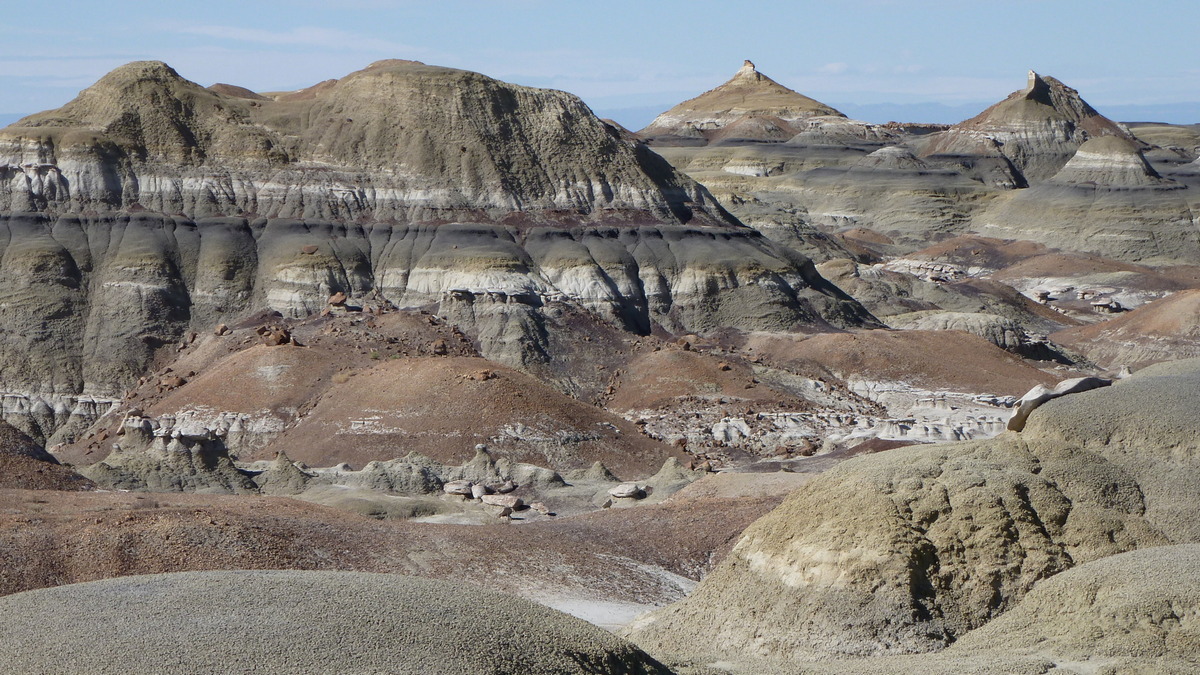
In some areas it is good to pay attention to your route and note landmarks, to avoid getting confused or even lost. There are no designated trails. But much of the wilderness is pretty open and walking is easy.
Presentation on Pope Francis's “Laudato Sí”
Pope Francis's “Laudato Sí” (On Care for Our Common Home) is the most widely read papal encyclical in history. The pope has been influential in encouraging world leaders to act on climate change. The Catholic archdiocese of San Antonio has formed a Laudato Sí Task Force to carry on a dialogue with members of all churches on the moral issue of preserving what is left of creation and protecting the most vulnerable from environmental chaos.
Does your church offer an opportunity for a presentation and discussion on these issues? The program can be tailored for time considerations. If interested, please call Darby Riley at 210-681-5889 or email darbyriley15@gmail.com
by Darby Riley, Alamo Group Political Chair
Compassion Tree Project
The Compassion Tree Project joins us all together in a single global effort to combat climate change by planting trees. See this flyer for information.
submitted by Darby Riley, Alamo Group Political Chair
Call for Writing and Visual Art
Literary magazine Voices de la Luna wants submissions of writing and art about Climate Chaos, Species Extinction and other environmental topics. This is for the 50th anniversary of Earth Day. See this flyer for information.
submitted by Darby Riley, Alamo Group Political Chair

Outings: The Call of the Wild
Visit the Alamo Sierra Club Outings page on Meetup for detailed information about all of our upcoming Sierra Club Outings.
The Alamo Sierran Newsletter
Richard Alles, Editor
Published by The Alamo Group of the Sierra Club, P.O. Box 6443, San Antonio, TX 78209, AlamoSierraClub.org.
The Alamo Group is one of 13 regional groups within the Lone Star Chapter of the Sierra Club.
Changed your mailing address?
Have you moved? Let us know by sending your old address, your new address and your member number (look on the upper left corner of your mailing label) to: address.changes@sierraclub.org.
Go online for the latest news and events
 |
